June 2013
Defense Secretary Voltaire Gazmin starts the ball rolling for the acquisition of two brand new frigates, worth P18 billion, for the Philippine Navy through Acquisition Decision Memorandum No. 2013-019.
Defense Secretary Voltaire Gazmin starts the ball rolling for the acquisition of two brand new frigates, worth P18 billion, for the Philippine Navy through Acquisition Decision Memorandum No. 2013-019.
Commodore Ronald Joseph Mercado takes over as technical working group head of the Philippine Navy frigate acquisition project, around the same time he was designated as commander of Offshore Combat Force, the Philippine Navy unit in charge of the warships.
The Department of National Defense (DND) opens the bidding for the two frigates for the Philippine Navy with an approved budget of P18 billion.
Six shipbuilders are declared eligible by the DND Special Bids and Awards Committee in the first stage of the bidding. These are: Garden Reach Shipbuilders & Engineers (GRSE) Ltd. of India, STX France SA of France; Navantia Sepi (RTR Ventures) of Spain and South Korean firms STX Offshore & Shipbuilding, Daewoo Shipbuilding & Marine Engineering Co. Ltd. and Hyundai Heavy Industries Inc (HHI).
Commodore Mercado relinquishes his post as commander of Offshore Combat Force and is replaced by Capt. Robert Empedrad, who also takes over the frigate project’s technical working group (TWG) a few weeks later.
The Acquisition Decision Memorandum is amended, directing the implementation of the frigate acquisition project into two lots: an approved budget contract of P16 billion for Lot 1 (platform with launchers), which shall be procured through a two-stage public bidding; and P2 billion for Lot 2 (missiles and munition) which shall be procured through negotiated deal (government to government).
This means the purchase of the munition is separate from the frigate platforms.
The bidding resumes. The two lowest bidders are India’s Garden Reach Shipbuilders & Engineers (GRSE) with a bid price of $22 million or P15,047,704,000; and South Korea’s Hyundai Heavy Industries Inc. (HHI) with a bid price of $336,912,000 or P15,744,571,584. ($1 = P46.732)
The DND declares the GRSE as non-compliant due to deficiencies in the financial requirements of the project and failure to comply with Section 23.5.2.6 of the Implementing Rules and Regulations (IRR) of RA 9184 or the Government Procurement Reform Act.
This means the second lowest bidder, the Hyundai Heavy Industries, takes the place of GRSE. The contract is not signed yet, however, because a new administration is taking over and it might be viewed as a midnight deal.
Around this time, Rodrigo Duterte wins the presidential race.
The Philippine Navy’s TWG concludes that HHI is legally, financially, and technically capable to bag the project after a post qualification assessment in South Korea.
Rear Admiral Ronald Joseph Mercado joins the post qualification team in South Korea but says he was not part of the evaluation process.
“I was commander of the Philippine Fleet then so a special position was made for me for that post qual though I didn’t really deal on evaluating anything… I think this was a courtesy extended to me since I was the one involved in the major activities of the FAP (frigate acquisition project).”
Rodrigo Duterte is sworn in as the 16th President of the Republic of the Philippines. Delfin Lorenzana replaces Voltaire Gazmin as defense secretary.
Just after the post-qualification assessment of the Philippine Navy, news reports surface in South Korea that Hanwha Thales, one of the two CMS (combat management system) suppliers offered by the HHI, leaves its joint venture with Thales. Hanwha Systems becomes the surviving company after the withdrawal of Thales.
The other CMS supplier offered by HHI to the Philippine Navy is Tacticos of Thales Nederland.
Lorenzana issues a Notice of Award to HHI as the winning bidder for the two Philippine Navy frigates.
The Philippine Navy TWG and HHI hold a workshop to iron out the final details of the contract.
Both sides agree to update the bid specifications. The CMS should be compatible with Tactical Data Link 16, a military network used by NATO and allied forces to exchange data in real time.
It is also in the same workshop that HHI conveyed to the technical working group its desire to select the supplier of the ships’ subsystems.
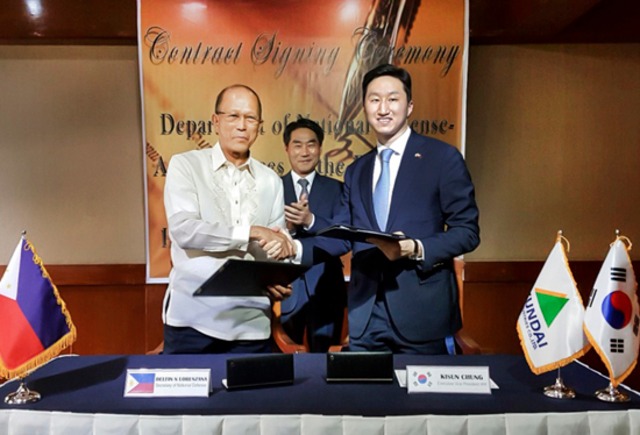
Defense Secretary Delfin Lorenzana and HHI Executive Vice President Kisun Chung sign the contract for the frigate acquisition project at the Philippine Navy headquarters in Manila.
Western Command chief Vice Admiral Ronald Joseph Mercado takes over as Navy chief. He replaces Vice Admiral Caesar Taccad.
Empedrad becomes project management team head of the frigate acquisition project.
Lorenzana issues the Notice to Proceed for the acquisition of 2 frigates from HHI.
Navy chief Vice Admiral Ronald Joseph Mercado writes to Defense Secretary Delfin Lorenzana to protest provisions which he says were inserted in the HHI maker’s list, or the list of proposed specific models and their manufacturers:
Mercado says the provisions were “grossly disadvantageous” to the Philippine Navy and the Department of National Defense.
“The remarks, if permitted, are akin to a buyer (PN/DND) with his/her own money being told by the seller (HHI) what to buy,” he writes.
“The use of the words ‘can be considered’ implies a mere suggestion on the part of the PN if and when a technically compliant and commercially competitive maker is available and demanded by PN to HHI,” he says.
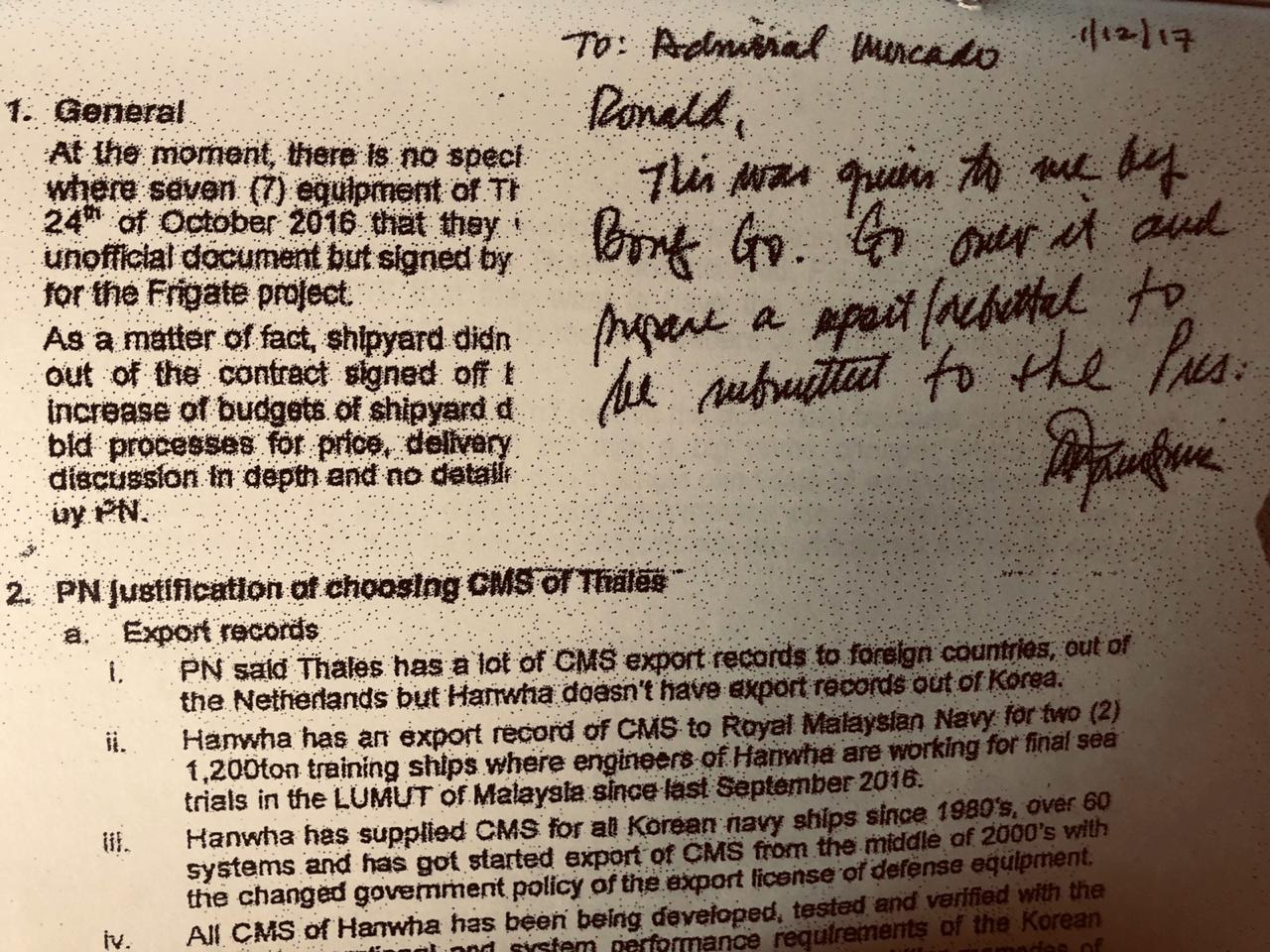
Lorenzana receives a white paper allegedly from Malacanang, endorsing the Hanwha Systems, the combat management systems (CMS) supplier chosen by Hyundai. He sends the white paper to Mercado with a post-it note, saying it came from then Special Assistant to the President Bong Go.
“To Admiral Mercado,” Lorenzana writes. “Ronald, This was given to me by Bong Go. Go over it and prepare a report/rebuttal to be submitted to the Pres.”
The white paper, purportedly from Hanwha, tried to discredit Tacticos Thales, the Navy’s preferred CMS supplier. Tacticos met the Navy’s requirement, which was included in the contract a month before the signing: The CMS should be compatible with Link 16.
Some of the points raised in the white paper:
Thales has CMS sales records in many countries including Korea, but end users have been suffering from poor support and logistics services. Many navies in Asia, including those in South Korea and South America, have complained about Thales’ supposed high price to keep systems up-to-date, allow installation of new equipment and upgrade or modernize old CMS.
It also says Hanwha will provide “the most economic and effective logistics and upgrade” of the CMS.
Bong Go’s office sends a letter to Commodore Robert Empedrad, then project management team head, asking Empedrad to discuss the CMS selection on Jan. 20 at the New Executive Building in Malacañang. The letter was signed by Undersecretary Christopher Lao of the Office of the Special Assistant to the President.
Empedrad submits a written report to Malacanang, addressed to President Rodrigo Duterte and Bong Go, explaining the Navy’s choice of Tacticos of Thales Nederland as CMS supplier.
He says Hanwha’s allegations that Thales customers have been suffering from poor support cannot be validated because there was no available report about it. In fact, there have been repeat orders from countries like Germany, Indonesia and Turkey, indicating their satisfaction with Tacticos.
Hanwha’s offer to provide “the most economic and effective logistics upgrade” remained to be seen, he says.
“The PMT (project management team) cannot quantify ascertain if the offer of HTC will be more economical than the offer of Thales Netherlands,” he says.
Capt. Sean Anthony Villa replaces Empedrad as the head of the project management team for the frigate acquisition project.
HHI writes to Col. Leodegario dela Paz (retired) of the Defense Acquisition Office, to inform that the price variation between Tacticos and Naval Shield ICMS was $7 million per frigate. This means that if the Navy prefers Tacticos, the DND should pay $7 million per frigate.
Mercado writes to Dela Paz (retired) of the Defense Acquisition Office to inform him that the Navy cannot endorse the HHI CMS selection for the frigates.
He also asks the DND to validate the supposed price difference in the offers of Hanwha Systems and Thales Nederland by seeing the actual commercial proposals of both companies.
“As long as the bid proposal of Thales does not go beyond the HHI price proposal for CMS during the Submission and Opening of Bid Envelopes (SOBE), the Thales should be considered as selected by the Navy,” he writes.
Assistant chief of naval staff for logistics Col. Antonio Mangroban writes to Lorenzana, responding to a memo issued by the DND on March 17, 2017. He recommends rejecting the HHI request for a suspension of the contract time for the frigate project.
“The Philippine Navy believes that the contract time should not be suspended as it is bereft of merit having no extenuating circumstances that would warrant such as provided in the IRR of RA9184.”
A suspension of contract means a temporary suspension of contractual obligations, usually called for when there are events outside of the control of both parties, without liability.
He also insists the “better CMS,” referring to Tacticos, should be selected. “The CMS selected by the PN, has in fact, not changed its cost since the SOBE.”
Dela Paz of the Defense Acquisition Office writes to the Philippine Navy, approving its recommendation to continue the project despite the request of HHI for a suspension of contract time: “There is no legal basis for the suspension of the contract time based on the foregoing issues.”
However, he also says the DND was “bound by the HHI selection of the maker for the CMS for the frigates provided that the CMS to be installed in the two frigates should be in accordance with the PN specifications and build aspects.”
He says that “the DND/ AFP shall not affect the payment under a progress billing scheme (agreed payment terms) if the Technical Inspection and Acceptance Committee report show non-compliance with the PN specifications, design and build aspects of the CMS.”
The Philippine Navy responds to the DND memo to reiterate that the HHI-selected CMS, the Naval Shield ICMS, did not comply with the Navy’s technical and build specification.
It cites Section VII of the DND FAP contract with HHI that the CMS must be of proven design with self-amplification that prototypes or still in development CMS are not allowed.
It says that Hanwha Naval Shield ICMS Link 16 compatibility is under development and will be made available by the year 2019.
HHI gets paid 15 percent of the P16 billion (P8 billion each for single frigate unit) contract price.
Lorenzana writes to then AFP chief Gen. Eduardo Año to discuss the frigates issue. He explains that HHI has the “sole right” to choose the subsystems of the frigate as stated in the contract.
He says in the letter that both Tacticos Thales and Hanwha Thales were declared compliant during the post-qualification stage.
“Compliance with the CMS specifications was further reiterated by Hyundai representative during a meeting at the DND on July 10, 2017. With the foregoing unequivocal statement from the principal contractor concerning compliance with the specifications on CMS, the issue raised by the PN must be put to rest,” Lorenzana says.
“To assail at this point in time the qualification of Hanwha Thales of South Korea as the selected “maker” of the CS by Hyundai, this Department finds it improper for no less than the PN technical team which had post qualified for CMS subsystem thereby declaring two subsystem contractors as compliant,” he adds.
Lorenzana creates a steering committee, headed by Defense Undersecretary Raymundo Elefante, to serve as his advisory body in the implementation of the frigate acquisition project.
Defense Undersecretary Cardozo Luna writes a memo ordering Mercado “to refrain from further communications…relative to the CMS issue with caution that this Department will not entertain any communication or pleadings bearing on the same issue.”
Mercado was warned of “disciplinary action” if he would further trifle with the directive.
Mercado confirms receipt of the DND memo. He says the Navy will “proceed without haste on the execution of the project as per contract agreement."
Elefante writes to Mercado about the Navy’s failure to submit the check list for the Technical Inspection and Acceptance Committee. The Navy was requested to submit within three days a letter to explain why the required document was not submitted on the requested date.
“Failure to comply shall be dealt with appropriate disciplinary action,” he says.
A draft of a supposed unsigned letter of Lorenzana to President Rodrigo Duterte, asking to remove Mercado from his post, is leaked to some members of media.
Mercado receives a text message saying that he is relieved from his post as Navy chief for alleged insubordination.
Mercado is removed as Philippine Navy chief. Empedrad, then deputy chief of staff for reservist affairs, replaces him in an acting capacity in a low-key turnover ceremony at the AFP General Headquarters.
Lorenzana holds a press conference about the sudden relief of Mercado.
“I have lost trust and confidence in his integrity and leadership. I questioned his intention behind his fixation with one specific company for the combat management system of the frigate,” he tells reporters.
He says it was clearly specified in the contract that the shipbuilder, the HHI, had the “sole right” to choose the subsystems in the frigates.
Lorenzana says Mercado’s refusal to let the HHI choose the CMS supplier had resulted in the delay of the project.
Duterte, in a separate interview with reporters, denies he had knowledge about the sacking of Mercado.
“I don’t know. Hindi ako ang nag-a-ano niyan. I have to ask. You know, I do not really interfere in the Armed Forces. Hinahayaan ko ‘yan sila diyan. Mag-reshuffling, whatever, transfer. I do not interfere, even with the police. I only sign sa kanila ‘yung promotion; appointments, none.”
Defense Secretary Delfin Lorenzana’s note to Navy chief Vice Admiral Ronald Joseph Mercado with Special Assistant to the President Bong Go’s name in 2017 about the white paper leaks to the press.
“My name has been unfairly dragged in this issue. I am not privy to the frigate transaction of the DND. I have never seen the controversial document that is alleged to have come from me, much less, handed the same to SND Lorenzana,” Go says in a statement on January 17.
“In fact, I will resign if it can be proven that I intervened. It should be emphasized that the frigate project was already a done deal in 2016 during the time of former President Aquino,” he adds.
Sacked Navy chief Vice Admiral Mercado, now on floating status, clears Go of any involvement in the frigate deal.
“Ilang beses kami na magkasama ni Secretary Bong Go, ilang beses kaming mag kausap. In fact, pag nag-escort ako kay President (Duterte) aboard foreign navy ships, gaya nung sa China, Pakistan, Japan, ni isang beses ‘di kami nag-usap tungkol sa Navy frigate project,” Mercado says in a Radyo Pilipinas interview on Jan. 20.
Local media report that Hyundai Heavy Industries was banned by South Korea government from participating in state-led projects for two years (until Nov. 2019) because of bribery.
Senate conducts an inquiry into the frigate acquisition project. What happened there:
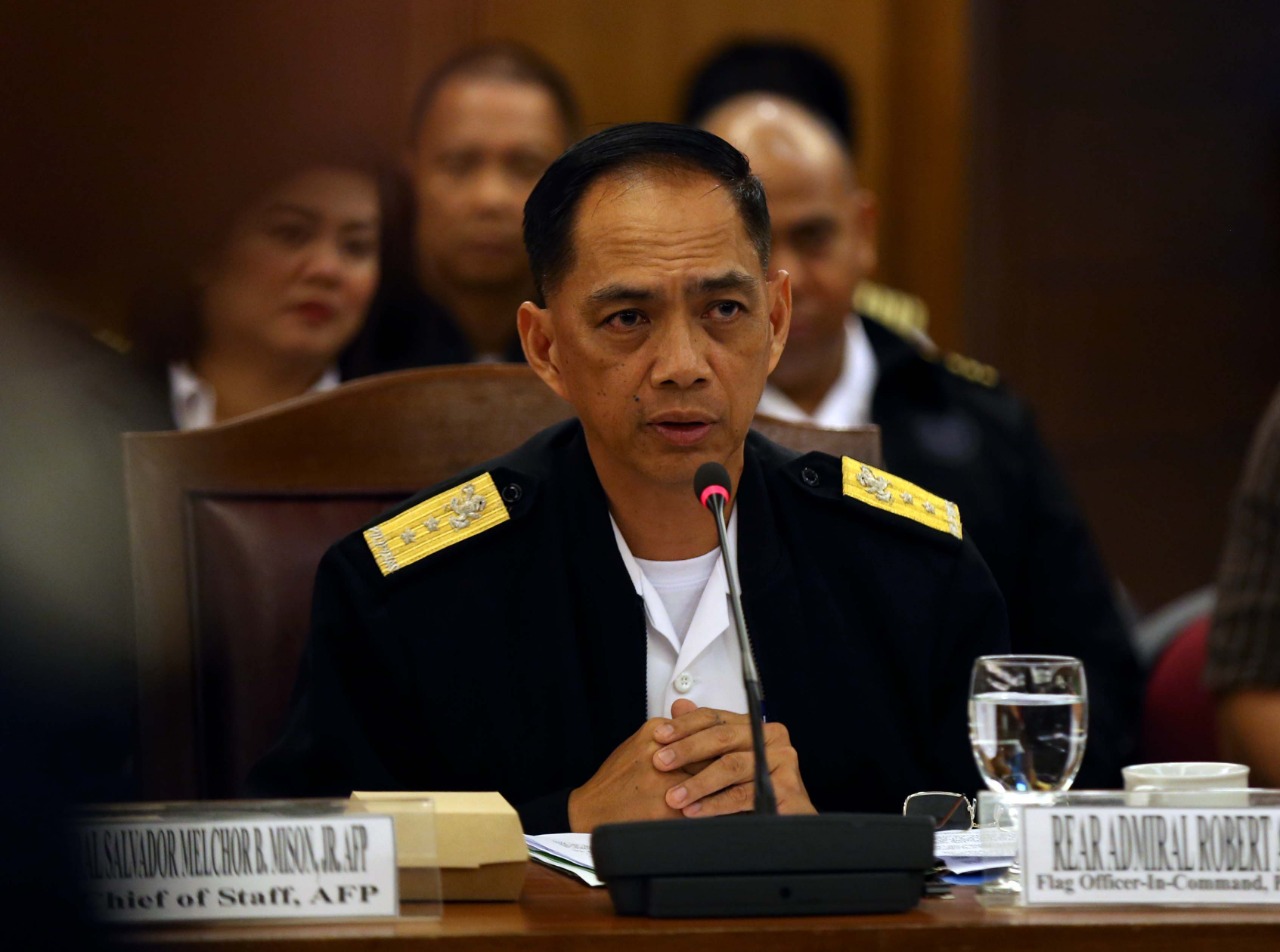
The House of Representatives’ committee on National Defense and Security holds a hearing to look into the frigates deal.
Navy chief Rear Admiral Robert Empedrad says it was he who approved the provision allowing HHI to have the “sole right” to choose the subsystems for the Navy frigates.
“I asked (our legal officer) if we have the authority to choose (the subsystem) and he said it’s forbidden, forbidden by RA 9184. So that was the reason why we decided…one of the reasons why decided, we agreed that it’s Hyundai Heavy Industries will select the subsystem.”
"The final selection of maker to be the shipbuilder's sole right is not absolute. It can only be exercised as long as the equipment and system fulfill the requirement and other design and build aspects," he says.
He says this was actually advantageous to the Navy because "engaging suppliers of more than 200 minor and major subsystems is beyond the project management capacity of the Philippine Navy.”
Lorenzana and Empedrad now no longer vouch for Tacticos. Earlier at the Senate hearing, they said they preferred it but they have a contract to follow. Empedrad now says Tacticos Thales and Hanwha Systems are both “equally compliant.”
“Your Honors, mga mahal kong kababayan, wala pong kayang gawin ang Tacticos na di kayang gawin ng Naval Shield,” he says.
Lorenzana also says he relieved Mercado but with the approval of Duterte. He says he wrote a letter to the President recommending Mercado’s relief, but the President’s approval was not done in writing.
AFP vice chief Salvador Mison Jr. says there was no recommendation from the board of generals about Mercado’s relief.
Mercado retires quietly as he turns 56 years old, the military’s mandatory retirement age.
Thales Nederland, the supplier of the Tacticos Thales CMS preferred by the Navy, writes to Magdalo Rep. Gary Alejano in response to his questions about the frigates deal.
It refutes the claim of Defense Secretary Delfin Lorenzana in the Senate hearing that Hyundai rejected Tacticos because of the supposed P700 million price increase.
“At the date of the Submission and Bid Openings and Evaluation (SOBE) the price of the Tacticos CMS was defined under a proposal submitted by Thales to HHI on March 11, 2016. This proposal was originally valid up to June 30th 2016, but its validity had been extended with no price changes at the request of HHI up to Jan. 31, 2017,” a Thales official tells Alejano.
“It is to be noted that the contract for the FAP was awarded in October 2016, and that HHI therefore had up to January 31, 2017 to grant a sub contract for Tacticos to Thales without any price increase,” the official says.
This means that Thales Tacticos did not increase its price for HHI between March 11, 2016 to Jan. 2017. Thales says after HHI signed with DND in October 2016, HHI had until Jan. 31, 2017 to grant a sub- contract for Tacticos to Thales without any price increase.
It says that on May 30, 2017, HHI informed Thales that its offer for Tacticos CMS was rejected.
Thales says that after Jan. 31, 2017, it did increase the price of Tacticos to 247,630 euros (for the 2 systems).
247,630 x 64.13 = P15,880,344.73
FOREX at that time: 1 Euro = P64.13
Alejano says HHI employed the strategy called “bait and switch,” which means the contractor baits the client by offering superior systems or products but once it bags the contract, it will find ways to go around it and choose lesser or cheaper systems to maximize profits.
The Technical Inspection and Acceptance Committee approves the critical design review or blueprint of the frigate acquisition project. This means the design is finalized and the shipbuilding work can finally begin.
HHI gets paid 5 percent of the P8 billion unit cost.
Steel cutting ceremony for P159 (project number of first of two frigates) at HHI shipyard in Ulsan, South Korea. This marks the official start of the first step of a vessel’s construction journey.
HHI receives 10 percent payment of the P8 billion unit cost.
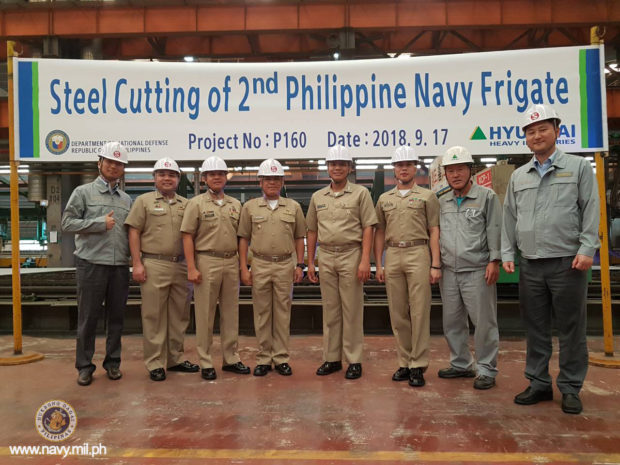
HHI cuts first steel for P160 (project number of the second frigate) at HHI shipyard at the Shin Hwa Tech facility in Pohang City, South Korea.
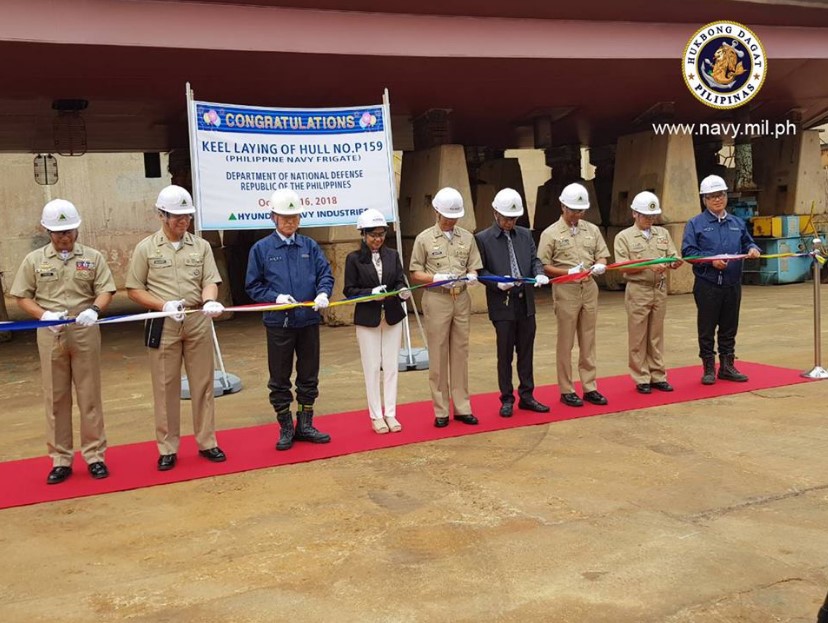
HHI holds keel laying ceremony for P159 at HHI shipyard in Ulsan, South Korea.
Keel laying is a naval shipyard tradition that marks the formal start of the construction of the ship.
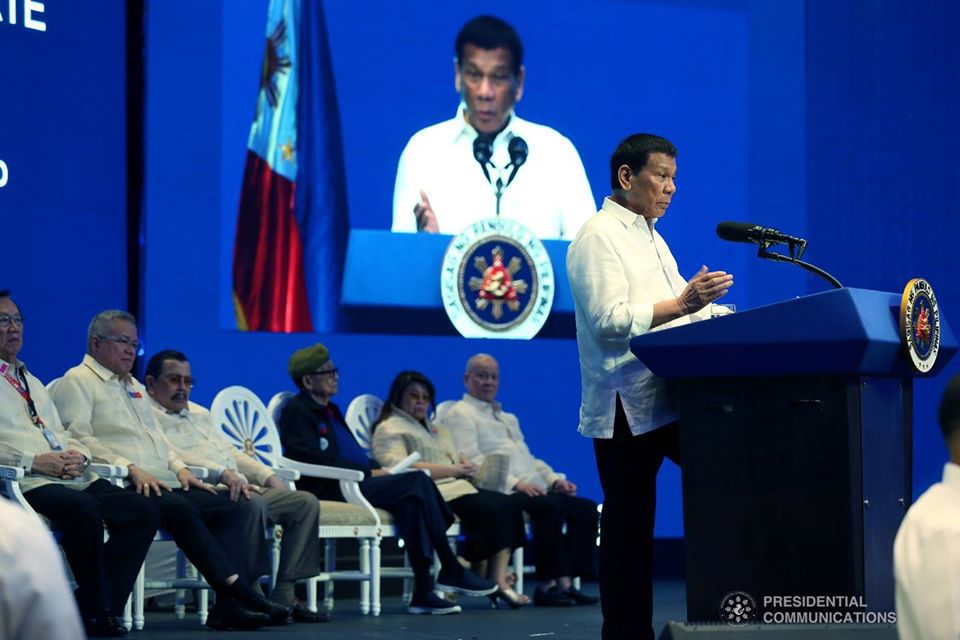
At the 44th Philippine Business Conference and Expo in Manila Hotel, President Rodrigo Duterte speaks about the frigates deal for the first time. He admits that he had knowledge of it.
The President says that he acted on a complaint of a South Korean firm, which apparently meant HHI or Hanwha had approached him about the project.
"There was this Korean who represented this …and he was complaining why there has yet no order to deliver na nanalo sila. So, yung letter niya ibinigay ko kay Bong, 'give it to legal,'" Duterte says in his speech.
"So legal referred it to Lorenzana. So ang nagsulat si Lorenzana," he said.
HHI gets paid 10 percent of the P8 billion unit cost.
Lorenzana announces at a press conference the names of the two future frigates of the Philippine Navy being built by HHI: BRP Jose Rizal and BRP Antonio Luna. “They are our heroes. We already have Davao del Sur and Tarlac. Now, we will name them after our heroes.”
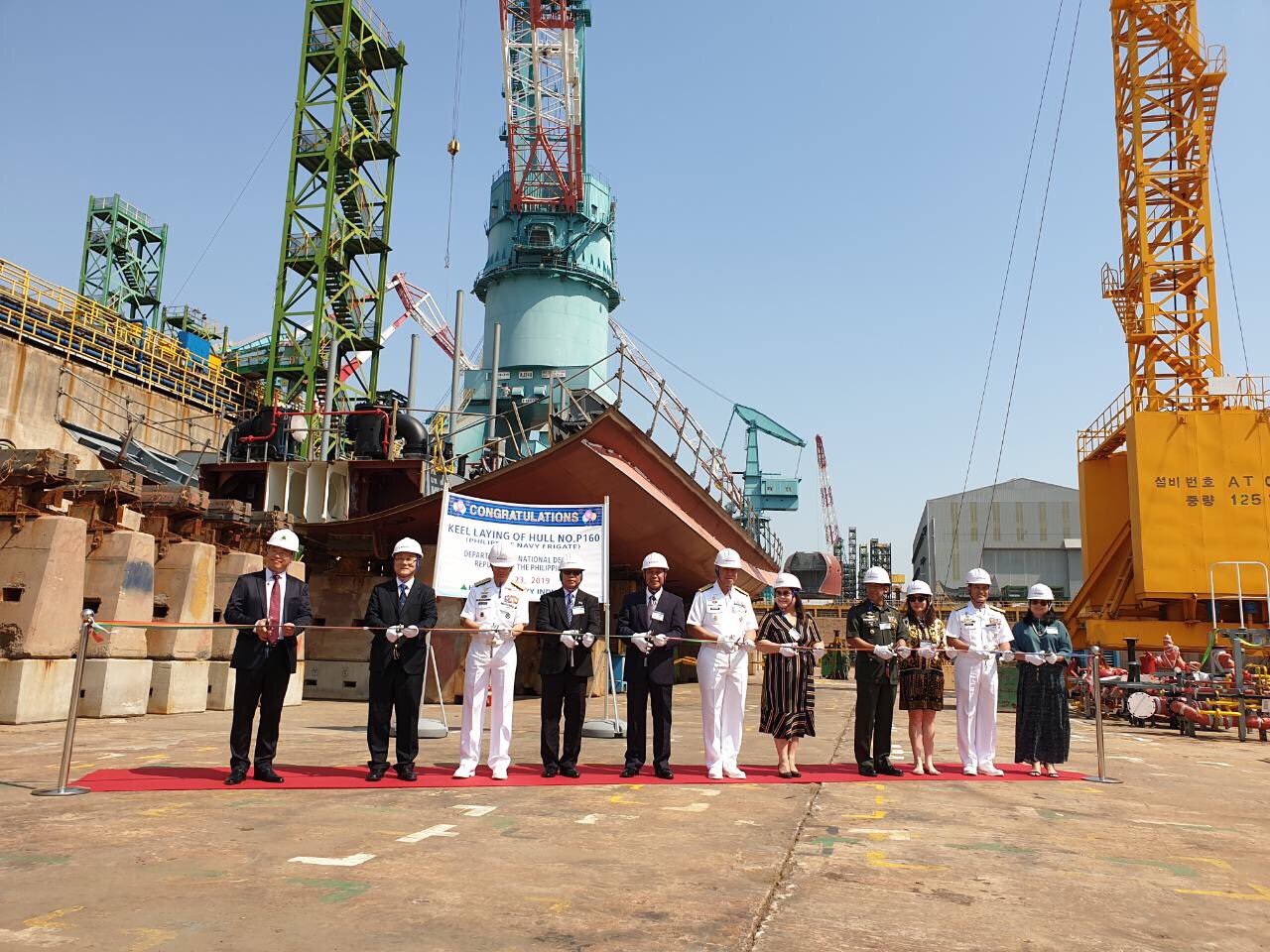
HHI holds keel laying ceremony for the second frigate BRP Antonio Luna at HHI shipyard in Ulsan, South Korea.
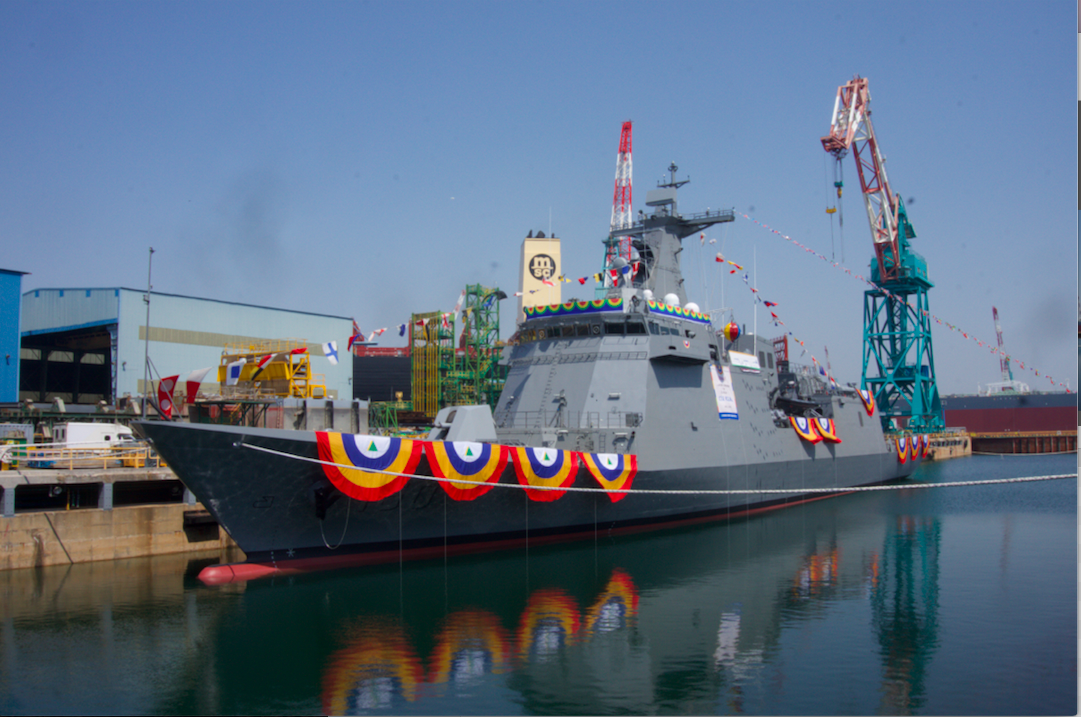
On the same day, HHI launches BRP Jose Rizal at HHI shipyard in Ulsan, South Korea. This is the ceremonial transfer of the vessel to water for the first time.
Philippine media delegation tours the Hanwha Systems in South Korea. Hanwha official says Link 16 will likely not be compatible for the frigates until 2020 because of issues between US and South Korea.
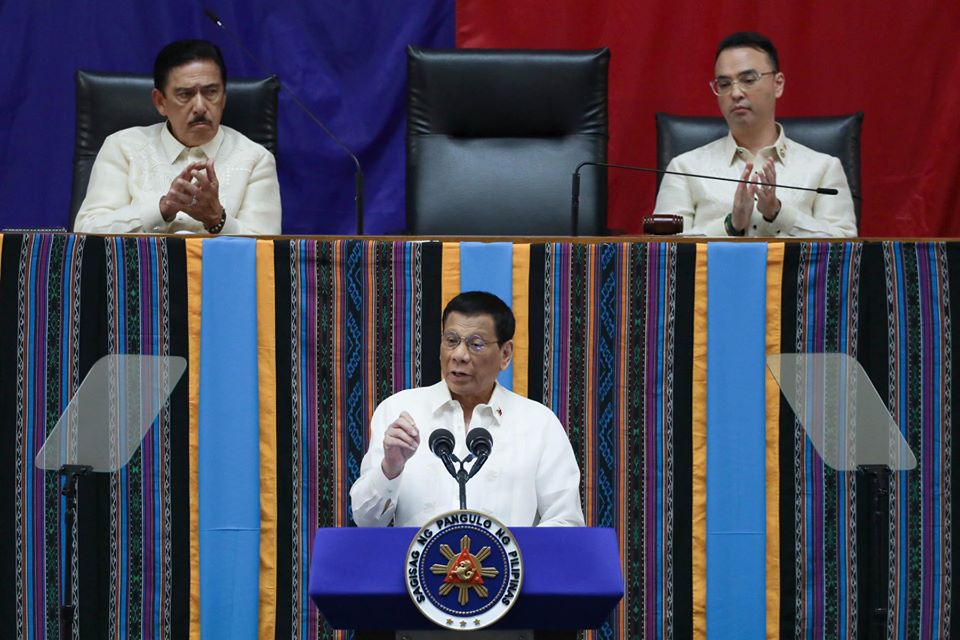
Duterte mentions the frigates deal again during his State of the Nation Address. He says the controversy helped Go land a seat in the Senate.
“And that is why that Korean went to Malacañang just to complain why is it that there is no request for delivery. So I told Bong, ‘Bong, ayusin mo ‘yan.’ He went to Lorenzana and Lorenzana nagsulat siya.” he says.
HHI receives 7 and 8 percent payment (2 separate milestones) of the P8 billion unit cost.
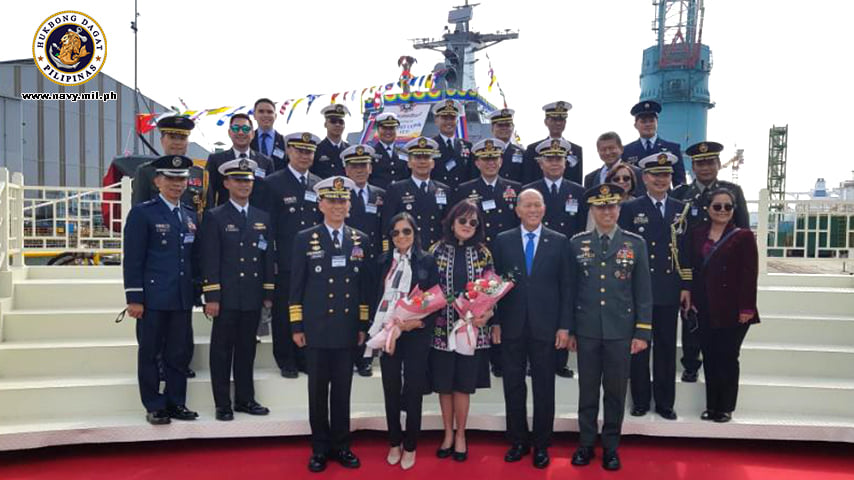
HHI launches the second frigate BRP Antonio Luna at Ulsan shipyard in South Korea.
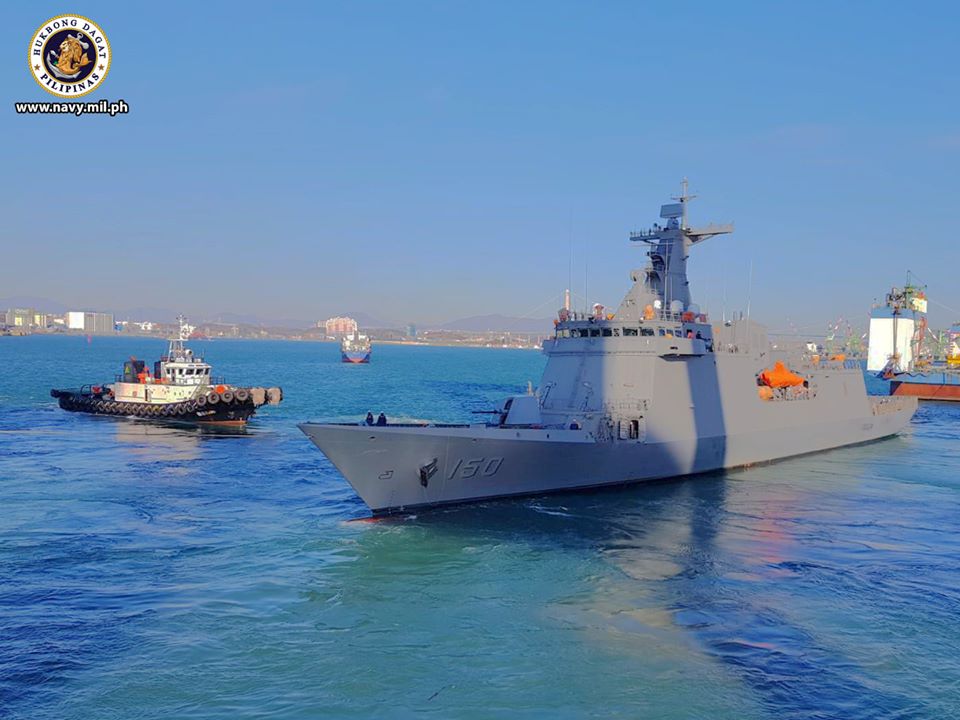
HHI holds first sea trials for BRP Jose Rizal in the waters off Ulsan, Busan and Mokpo in South Korea.
HHI holds second round of sea trials for BRP Jose Rizal.
HHI gets paid 8 percent of the P8 billion unit cost.
Hyundai Heavy Industries (HHI) holds third and fourth sea trials for BRP Jose Rizal.
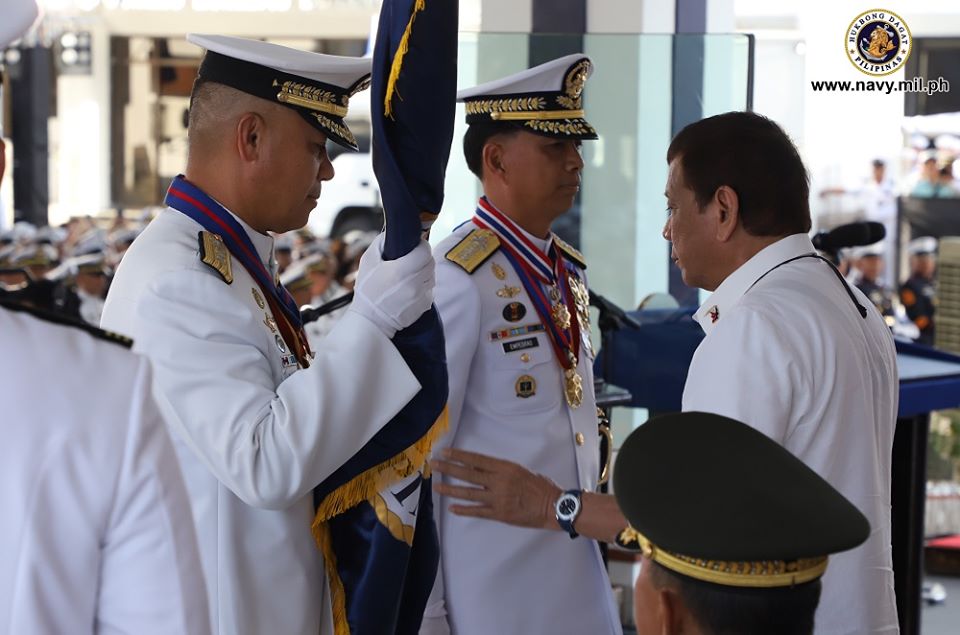
Vice Adm. Robert Empedrad retires as Navy chief as he reaches the compulsory retirement age of 56.
HHI holds fifth sea trials for BRP Jose Rizal.
The entire team of the Technical Inspection and Acceptance Committee witnesses the sea acceptance tests for BRP Jose Rizal in South Korea. It had “generally satisfactory” results, says the Philippine Navy.
Duterte names Empedrad as the new administrator of the Maritime Industry Authority.
Navy chief Vice Adm. Giovanni Carlo Bacordo tells the media that the delivery of the first frigate, BRP Jose Rizal, set for late April, is likely to be delayed due to the coronavirus pandemic.
HHI President and CEO Yeoung Seouk Han writes to Defense Secretary Delfin Lorenzana, proposing the immediate delivery of the BRP Jose Rizal and the conduct of the final acceptance evaluation in the Philippines. Travel restrictions brought by the coronavirus pandemic have prevented the Philippines’ Technical Inspection and Acceptance Committee (TIAC) from going to South Korea to conduct pre-delivery inspection.
The letter also discusses the issue on Link 16 compatibility, one of the contract requirements. The HHI President mentions that the combat management systems (CMS) and Link 16 interoperability were tested successfully using the Ultra Electronics’ ADSI test equipment. However, it says that it could not yet obtain the additional US certification required by the TIAC.
“With regard to ADSI-related certificate that was additionally requested by TIAC, HHI and Hanwha representatives visited the Ultra Electronics in the US and verified the certificate with their naked eyes; however, as it is a classified document that requires the prior approval of the US government for provision to third parties, it has been confirmed that it is a force majeure that the certificate cannot be submitted at this time,” Yeoung writes.
“Therefore, we have no choice but to submit the confirmation letter by the ROK Minister of National Defense as well as relevant document by DAPA in lieu of the certificate of the ADSI test equipment.”
The HHI president also tells Lorenzana that the Korean firm was experiencing difficulties in the construction of the second frigate, the BRP Antonio Luna, as there are challenges in commissioning certain equipment because of COVID-19 travel restrictions affecting manufacturers’ engineers.
“I firmly promise that I will do my best to deliver high-quality vessel within the contractual schedule,” he says.
Yeoung also says his company was donating relief medical supplies, which will be delivered along with BRP Jose Rizal.
Korean Minister of National Defense Jeong Kyeongdoo writes to Lorenzana on April 20, providing guarantee that the ADSI of Ultra Electronics is accredited to conduct Link 16 compatibility tests.
“It is my understanding that the Philippine side, for the final approval on the compatibility of the CMS with Link 16, has requested confirmation on whether there is any record of the ADSI that was used during the test receiving US JITC certification,” he writes.
“It has been verified with the US manufacturer of the ADSI, Ultra Electronics Limited that the ADSI has received the Link 16 compatibility certification of the US JITC,” he says.
Jeong says that the ROK Defense Communication Command and the Agency for Defense Development have also adopted the ADSI from the same US manufacturer, Ultra Electronics Limited and are conducting Link 16 compatibility tests.
“With these facts as the basis, I would like to request your active support so that the approval for the compatibility of the CMS with Link 16 may be given soon and lead to the successful delivery of frigate number 1,” Jeong says.
On the same date, Lorenzana writes back to the HHI president, welcoming the request for delivery of the BRP Jose Rizal to the Philippines with two conditions:
The submission of the Letter of Guarantee from manufacturer and confirmation from ROK Ministry of Defense in lieu of the certification of the interoperability of the vessel’s CMS and TDL 16 is sufficient for the DND to accept the HHI’s suggestion to conduct the final acceptance evaluation of the frigate here in the Philippines, Lorenzana says.
BRP Jose Rizal leaves the HHI shipyard in Ulsan, South Korea and begins her journey to the Philippines.
BRP Jose Rizal arrives in Subic Bay, Zambales after a five-day voyage. The technical inspection and acceptance will be carried out after the mandatory quarantine period. A commissioning ceremony is tentatively set on June 19, the birthday of the ship’s namesake, Dr. Jose Rizal.